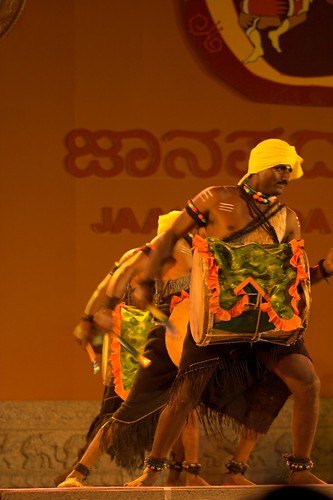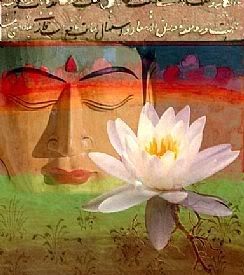











Giddha - it's a truly colorful dance of punjabi womens.Women have a different but no less exuberant dance called gidda. The dancers enact verses called bolis, which represent folk poetry at its best. The subject matter of these bolis is wide ranging indeed – everything from arguments with the sister-in-law to political affairs figure in these lively songs. Aside from the drums, the rhythm of this dance is set by the distinctive hand-claps of the dancers Giddha is a very vigorous folk dance and like other such dances it is very much an affair of the legs. The embroidered duppattas and heavy jewelry of the participants whose number is unrestricted further exaggerate the movements.











Kamsale is a unique folk art performed by the devotees of God Mahadeshwara - Lord Shiva. Kamsale is a brass made musical instrument. Its origin is traced to the mythological period. Kamsale is closely connected with a tradition of Shiva worship. The artists who have vowed to live a life of devotion to lord Mahadeswara are supposed to performs Kamsale. The Dance is a part of diksha or oath and is taught by the teacher and spiritual leader.
The Kamsale dance is named after the instrument held in the hands of the dancer. The artists, with the Kamsale in the left hand, expose it to be hit by the Kamsale held in the right hand.The instruments, in the course of the vigorous rhythmic beatings are moved around the body of the dancer in innumerable patterns manifesting both skill and art.
 Dollu Kunitha (dance), is a major form of art, occupies the pride of place among folk dances. Dollu Kunitha is a popular drum dance of Karnataka accompanied by singing.
Dollu Kunitha (dance), is a major form of art, occupies the pride of place among folk dances. Dollu Kunitha is a popular drum dance of Karnataka accompanied by singing.
 In all temples of Beereshwara, it is a religious practice that the major instrument Dollu be hung in the premises of the temple by means of a thick thread tied up to the hooks fixed in the ceiling. Every time pooja is offered to Beereshwara, the custom demands that there should be an instantaneous beating of the Dollu as an accompanying act of worship. Dollu dance has gone on uninterruptedly generation after generation with renewed vigour and raciness of performance. Hardly any religious performance of a ritualistic ceremony or any village festival can ever take place without this dance, especially in North Karnataka.
In all temples of Beereshwara, it is a religious practice that the major instrument Dollu be hung in the premises of the temple by means of a thick thread tied up to the hooks fixed in the ceiling. Every time pooja is offered to Beereshwara, the custom demands that there should be an instantaneous beating of the Dollu as an accompanying act of worship. Dollu dance has gone on uninterruptedly generation after generation with renewed vigour and raciness of performance. Hardly any religious performance of a ritualistic ceremony or any village festival can ever take place without this dance, especially in North Karnataka.


 The lotus flower is one of the most ancient and deepest symbols of our planet. The lotus flower grows in muddy water and rises above the surface to bloom with remarkable beauty. At night the flower closes and sinks underwater, at dawn it rises and opens again. Untouched by the impurity, lotus symbolizes the purity of heart and mind. The lotus flower represents long life, health, honor and good luck.
The lotus flower is one of the most ancient and deepest symbols of our planet. The lotus flower grows in muddy water and rises above the surface to bloom with remarkable beauty. At night the flower closes and sinks underwater, at dawn it rises and opens again. Untouched by the impurity, lotus symbolizes the purity of heart and mind. The lotus flower represents long life, health, honor and good luck.
Eastern lotus flower
The Lotus flower is viewed as a representation of spirituality according to the eastern culture. The lotus flower is often viewed as a symbol of aspirations to rise towards the light as the roots of the lotus flower has its roots in the mud but it grows in the upward direction.
Egyptian lotus flower
According to the Egyptian culture the lotus flower symbol was known by the name of 'Sesan'. As per the mythology of Egypt the lotus flower symbolized the sun as well as formation and revival.
Christian lotus flower
The lotus flower is a representation of piousness and fertility. The lily flower in the Christian culture basically replaces the lotus flower. The lily flower according to the Christian culture is associated with Mary who is known as the queen of heaven.
The lotus flower has been given a sacred place in Indian culture. It plays a huge role in the art and mythology there and has done so for centuries. In Indian society, the lotus represents divinity, fertility, wealth, knowledge, and enlightenment. Perhaps the reverence of the flower stems from the fact that is an unquestionable beauty despite the fact that it grows out of murky waters and mud. Because of its ability to grow in the water, the lotus is often referred to as the water lily.It is mentioned in all the Hindu scriptures because it is very sacred to the Gods.

The indian poets have used the lotus as a simile in praise of the feet of the Gods and Goddesses. All the Vedas sing in praise of the lotus. In the Yogasastra, the six Chakras are depicted with the lotus as the base. According to the Mahayana sect of Buddhism, all the souls originate from the lotus.


- beautiful , agreeable, illustrious , noble , generous, excellent , virtuous , good, beneficial , salutary , auspicious ; happy , prosperous , fortunate , lucky , well , right, good fortune , happiness , prosperity
rUpa: - form
(from sanskrit-english dictionary)